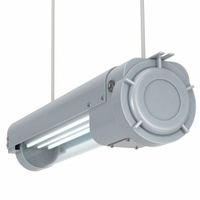- Home
- Lighting
- Lighting Fixtures Retrofit Kits
- Hazardous Location Lighting Fixtures
- Linear Hazardous Location Light Fixtures
Linear Hazardous Location Light Fixtures
The long, linear body of these hazardous location lighting fixtures spreads light over a wide area for more coverage per fixture than round lights. They mount to flat surfaces where there's enough space for the larger fixture footprint and illuminate areas with flammable, combustible, or ignitable m .....Read More
Frequently Asked Questions
What are hazardous location lighting fixtures?
How do hazardous location lighting fixtures prevent fires and explosions?
What are the class and division ratings for hazardous location lighting?
What is the difference between Class I and Class II hazardous location fixtures?
Why are LED lights preferred for hazardous location lighting?
How do fluorescent lights compare to LED lights in hazardous locations?
What are the group ratings for hazardous location lighting fixtures?


